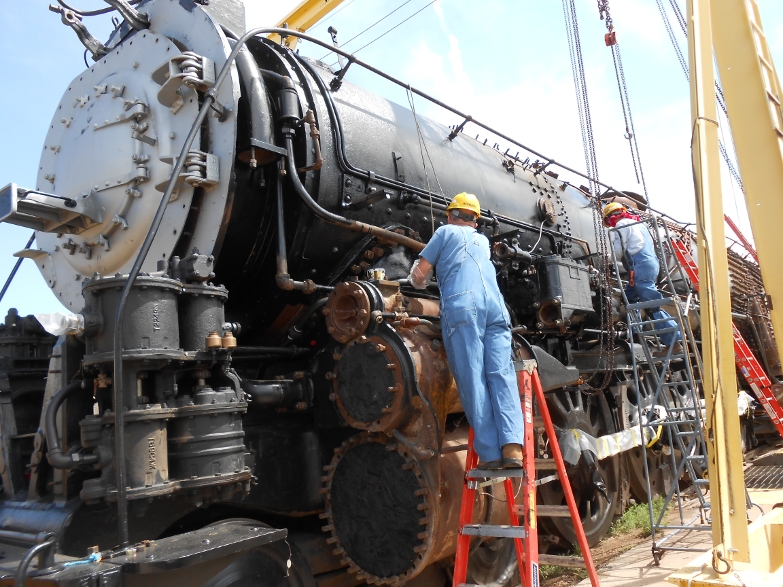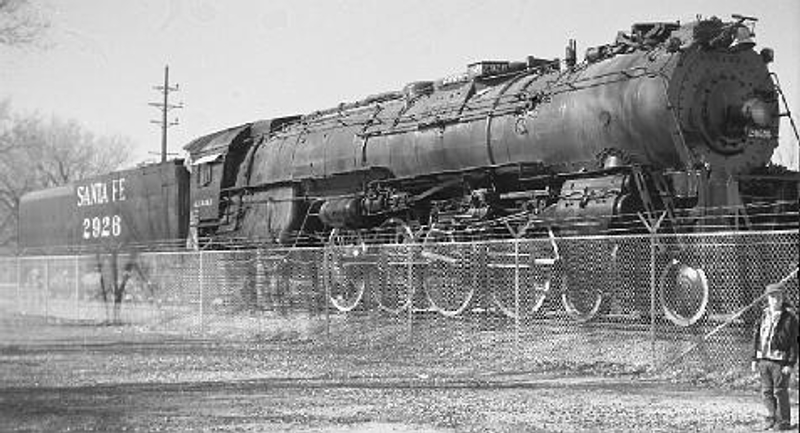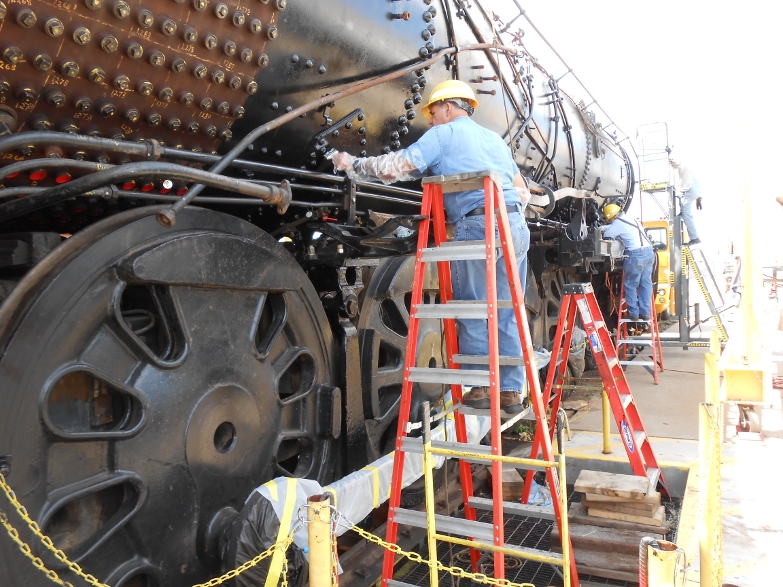[one_full]

Project Information:
Project Name: 1944 Sante Fe 2926 Steam Locomotive
Contractor and Applicator: Dr. Mike Hartshorne & approximately 20 Volunteers
Application Type: Spray, Roll, Brush
USA
2008 to present
Project Description:
“If a group of volunteers could revive this rust bucket, picture just what your team of rust proofing pros could do!” by Brad Gillette / 11.02.2010
Most Saturday mornings, Mike Hartshorne, M.D., chief of radiology in Albuquerque, New Mexico Veterans Hospital and professor of radiology in the University of New Mexico, dons a Tyvek suit, gloves, and hard hat and straps on a DBI/SALA Stop II protection funnel secured to a lifeline. Armed with an Ingersoll-Rand 125 needle-scaler and a flashlight, he climbs down into an enclosed space that, for many, may really feel just like the very bowels of hell.
Hell is the 24,000-gallon water tank of the Santa Fe 2926, a 60-year-old steam engine locomotive undergoing the slow process of restoration, in fact it is one of the four dirtiest places in Albuquerque, in Hartshorne’s evaluation. Dr. Mike’s mission on this day will be to get rid of a 3/8″ thick layer of calcium carbonate locally referred to as caliche which clings to the metal, along with baked-on grease inlayed with sand, plus a gooey, Vaseline-like asphalt, and rust that’s stuck between the layers of steel in the locomotive’s fuel tender. Bound by a desire for locomotives, Hartshorne and the 20 or so other volunteers which congregate in the construction site on Wednesdays and Saturdays really feel duty-bound in order to restore the locomotive to its original 1944 operating condition. Experienced in jobs who have nothing related to surface prep and coating including pastor, policeman, college professor, firefighter, dentist, electrician, auto mechanic, small-business owner, lab technician, and radiologist they donate hundreds of hours of hard physical work. It’s all in the desire that, some six years and 0,000 from now, they will see the 2926 smoking along at 100 mph, tugging excursion trains over the Southwest on tracks possessed by Burlington Northern Santa Fe. The Santa Fe 2926, a 1944 steam locomotive left abandoned in an Albuquerque city park a half-decade ago (background), might pull excursion trains once more. It’s been adopted by the New Mexico Steam Locomotive and Railroad Historical Society, whose members volunteer a number of hours a week to its repair. The cleaning and coating of the 2926 began in April 2003 and is expected to take at least six more years.
Radiologist Mike Hartshorne, M.D., wearing an air-supplied hood, heads to the bowels of the tender’s sandbox, watched carefully by retired cop Ken Dusenberry, to whom he is secured by protection harness. The sandbox stored sand that has been fired through the locomotive’s firebox to maintain its engine free of smoke. It’s not a job for the claustrophobic, says Hartshorne, who needed to overcome his fear of enclosed areas in order to clear the interior of soot and gooey asphalt.
Among the Largest, Heaviest, and Most-Powerful Steam Engines At 121′-long and almost one million pounds, it was among the largest, heaviest, and most effective 4-8-4s (which describes the wheel settings) ever constructed. Only 6 of these remain, none operable. Just like the 2926, they have been left to crumble in city parks around the region.
There’s been no preservation on them, notes Hartshorne. Every few years, somebody slaps a new coat of anything black on them. The 2926 was retired in Albuquerque’s Coronado Park in 1956, at which time it fell prey to vandals, graffiti taggers, and vagrants who lit fires in her caboose to remain heated through the night. Then, in 1999, the 200-member New Mexico Steam Locomotive and Railroad Historical Society (NMSL&RHS) purchased the locomotive from the city for , and started the titanic project of amassing money and manpower so that restoration work could commence.
Besides a grant from the city’s Wheels Museum, that eventually would like to see the locomotive as its centerpiece, the money has seeped in slowly. Bob DeGroft, a 65-year-old retired office-furniture supplier, keeps an eye on accounting, auditing, insurance, and other administrative tasks for the Society. Some of the money comes from just begging, he says, mentioning that many charities concentrate on humanitarian causes instead of fixing a piece of equipment. One such service was the June 2000 carting of the locomotive from Coronado Park on to the track where it’s being renewed. of Texas that cost 0,000. Says Hartshorne, We were able to spend about ,000, and, when I got to be chief executive of the Society, I asked everyone to dig deep to generate more money. Eventually, I got a call from Jack’s wife in Texas — somebody had sent him a copy of our newsletter. ‘He does not want the money,’ she stated. He excused more than 0,000 from what we owed him, and then came back two years afterwards and does some more work for us. All he got was a sign that said “Thanks, Jack”.
Dismantle individual sections of engine and tender.
Coat all surfaces with Rust Bullet, a rust-inhibitive coating.
SAFETY CONSIDERATIONS:
All volunteers receive 3-hour security orientation (PPE, HAZMAT, MSDS, confined-space) PPE includes steel-toed shoes, goggles, gloves, air-line respirators with hoods, and security harnesses secured with lifelines.
Confined-space work restricted to 30-minute increments. Crane Service Company of Albuquerque donated one of its large lift cranes along with a team to hoist the large oil tank out of the tender car and place it on wood shoring. Based on Society members, six decades of paint, mud, oil, grease, and tar encrusted the tank, inside and out, which makes it difficult to wrest the tank free. He climbs feet-first through an 18-diameter pit, rolls over on his belly, and then crawls on his hands and knees some twenty feet over the baffles to a location where he can finally stand up. The first couple of times I crawled in the water tank, I wasn’t thrilled about being there, he tells.
Close Awareness to Safety
The volunteer position of safety officer has been assumed by Jon Spargo, security officer for the Very Large Array (VLA) in Socorro, New Mexico, a series of giant radio telescopes run by the National Radio Astronomy Observatory. We have a lot of folks who are long on enthusiasm, but short on experience, explains Spargo, who says the procedure of bringing the volunteers up to OSHA security standards is like herding cats. “I walk a thin line” I don’t want to be overbearing and take the fun out of it, but I also don’t want anyone to get hurt, he says. “I want us to have the image of being extremely professional not a bunch of old geezers playing choo-choo. Apart from OSHA specifications, the restoration work must meet the very stringent safety guidelines of the Federal Railroad Administration (FRA), along with the Burlington Northern Santa Fe Railroad, from whom authorization must be granted to perform an excursion service. Spargo’s security attempts are assisted by Judy Sadel, a registered nurse and semi-retired firefighter, who has joined her husband, Bob, in becoming one of the team. When she’s not getting ‘down and dirty, Sadel operates a makeshift rehab station for the confined-space workers, equipped with a stethoscope, blood-pressure monitor, water, and Gatorade. Spargo spent early on in air-line respirators, security harnesses, and other security equipment, so that the volunteers never have to use shortcuts. He restricts confined-space work to half-hour increments, and always has a staff standing by to enter in case a problem should arise. Sparked by childhood thoughts of watching steam locomotives pass by, the Sadels, like the other volunteers, are all steam-engine aficionados. When all is said and done, says Sadel, “I can say I was part of it because I was actually doing things with the rest of the crew.”
A UNIQUE COATING
After hauling numerous hundred pounds of caliche out of the container, Hartshorne and the other volunteers use a pressure-washer altered with a blast-media delivery process in order to achieve a surface profile of bare metal or light rust. Copper slag from local New Mexico mines is the medium of choice. They have opted to paint the surface of the tender with a rust-inhibitive coating called Rust Bullet, which can be applied over light rust, provided the area is free of dirt and grease, says Hartshorne.
Created 22 years ago by a Los Angeles inventor who worked for NASA, the single-component, hybrid, moisture-cured urethane coating has been initially designed for Air Force aircraft, to shield the wingtips from scratching during flight, says Bob Murphy, president and CEO of Rust Bullet. Using Rust Bullet on the locomotive came from Bob Kittel of Long Beach, California, who had spearheaded a related repair project on the “3751″ steam locomotive for the San Bernardino (California) Railroad Historical Society. With his task efficiently completed, Kittel now serves as advisor for the Albuquerque venture. He had found out Rust Bullet on the Internet through his other hobby, restoring Model A Fords.
“I had used another product, which seemed tough, but it didn’t hold up to UV light or on locomotives,” he says. “A locomotive is a peculiar beast” it runs outdoors and it is basically a big boiler on wheels, with a lot of steam, water, etc., all of which have detrimental effects. Rust Bullet’s success on the “3751″ led Kittel to recommend it to the NMSL&RHS for the Albuquerque locomotive’s restoration. The two-application product penetrates the porous rust and reaches the metal beneath, altering isocyanates and water into a polymer matrix that gives off carbon dioxide, according to Murphy. Basically, the rust gets intertwined in the resin matrix and becomes a permanent component of the coating. “We didn’t trust it at first one of our volunteers, Paul Uhland, used to be in the Navy, and he said, “You can’t paint over rust! It will just trap the rust beneath it.” So we let it harden and then took a grinder to it. We couldn’t find any rust. There was clean metal under it.” The silver-colored Rust Bullet doesn’t require a topcoat, but will bond well to one if desired for appearance, says Murphy. “When you apply the product, it doesn’t form a film immediately, he explains. One factor Hartshorne has found out is that Rust Bullet does not come off skin except if it is removed right away his spouse had to file a chunk of the coating off his nose with an emery board. “I figure I’ll still be doing this when I’m an old man.”
[/one_full]


